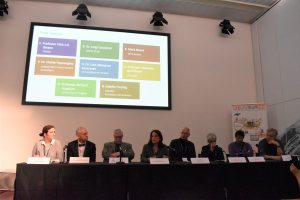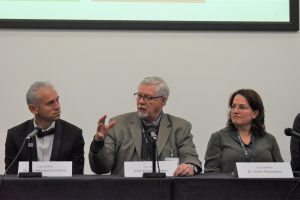Ground Truth 2.0 Week 2019 – Day 5
The last day of the Ground Truth 2.0 Week 2019 started with a market place, featuring the Ground Truth 2.0 tools and outputs. The Ground truth 2.0 partners were available at dedicated stations to introduce the participants to the tools and outputs, such as the Ground Truth 2.0 co-design methodology, the data quality module, citizen observatory tools and apps, the Gavagai monitor and many more.



After a short coffee break, the Ground Truth 2.0 week was closed with a panel discussion ‘Passing the torch’. Eight panellists shared their respective perspective on the uptake of specific Ground Truth 2.0 results in their respective project, activity, or field as well as the conditions for uptake.
Prof. Nick van de Giesen (TU Delft), coordinator of the TWIGA project, explained that while it may seem obvious how to involve people in Citizen Science, the Ground Truth 2.0 project highlights the importance of the involvement of citizens in the co-design of citizen science, as well as the fact that there is no “one size fits all” approach to citizen science. Dr. Luigi Ceccaroni, ECSA vice chair and innovation lead at Earthwatch, added that in the H2020 MICS project that he is coordinating, the Ground Truth 2.0 methodology is taken up in a “light” version to co-design citizen science activities in the 4 case studies in Europe. Mark Noort from the Africultures project, described how he received inspiration on how to involve citizens with the aim of tapping into the experience of citizens, such as farmers who could contribute lots of data.



Dr. Clairie Papazoglou, an independent environment expert, mentioned that she perceives citizen science as of great value for advocacy work, but also stressed the importance of not only gathering data, but also to analyze it, and to feed this back to the citizens in order to keep them engaged and motivated. The same thought was picked up by Dr. Luis Velasquez, who emphasized the importance of adjusting the ways in which one communicates about citizen science data to the target audience. He also stressed that the links between citizen observatories and health should be explored in more detail. The Ground Truth team added that there is a clear connection between health and the citizen observatories in Belgium: in Antwerp, KlimaatRobuust is directly linked with a project about care for the elderly as cool spots are mapped throughout the city that can help alleviate heat stress. For Meet Mee Mechelen, there is a very clear link with the health implications of bad air quality.
Prof. Charlotte de Fraiture, the Vice Rector of IHE Delft, talked about what IHE as an institute can do to take up the results of Ground Truth 2.0 in its research, education and capacity development activities. She suggested to integrate citizen science in the curriculum of the MSs programs at IHE, and expose the students to the richness of citizen science as more than just data collection illustrated by the Ground Truth 2.0 citizen observatories. Prof. Richard Hawkins added that we need to “enlarge our ranks” as there is a crisis in science when it comes to communication with policy makers. Everyone can contribute to knowledge and tools should be passed on to citizens in order to do so. He perceived Ground Truth 2.0 as a great example of this empowerment. Izabela Freytag from EASME at the European Commission touched upon the funding of citizen science projects. Since the outcomes of co-design processes are less predictable than more traditional approaches, flexibility is required when funding such projects.

